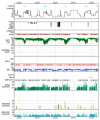Qualitative Phenotyping of Obstructive Sleep Apnea and Its Clinical Usefulness for the Sleep Specialist
- PMID: 32244892
- PMCID: PMC7143772
- DOI: 10.3390/ijerph17062058
Qualitative Phenotyping of Obstructive Sleep Apnea and Its Clinical Usefulness for the Sleep Specialist
Abstract
Introduction: The anatomical collapsibility of the upper airway, neuromuscular tone and function, sleep-wake and ventilatory control instability, and the arousal threshold all interact and contribute to certain pathophysiologic features that characterize different types of obstructive sleep apnea (OSA). A model of qualitative phenotypizationallowsus to characterize the different pathophysiological traits in OSA patients.
Methods: A narrative review was performed, to analyze the available literature evidence, with the purpose of generating a model of qualitative phenotypization to characterize pathophysiological traits in patients with OSA.
Results: 96 out of 3829 abstracts were selected for full-text review. Qualitative phenotyping model of OSA:Data concerning the OSA qualitative pathophysiological traits' measurement can be deducted by means of clinical PSG, grade of OSA severity, and therapeutic level of Continuous Positive Airway Pressure (CPAP) and are reported in the text. This approach would allow qualitative phenotyping with widely accessible methodology in a routine clinical scenario and is of particular interest for the sleep specialist, surgical treatment decision-making, and customized OSA multimodality treatment.
Keywords: CPAP; obstructive sleep apnea; pathophysiological traits; phenotypization.
Conflict of interest statement
The authors declare no conflict of interest.
Figures




References
Publication types
MeSH terms
LinkOut - more resources
Full Text Sources

